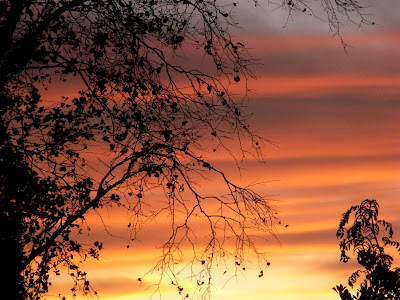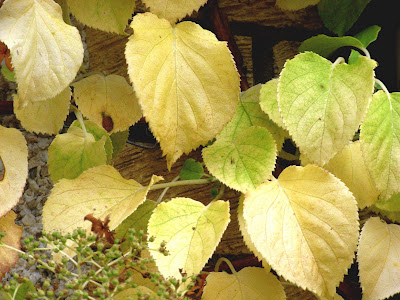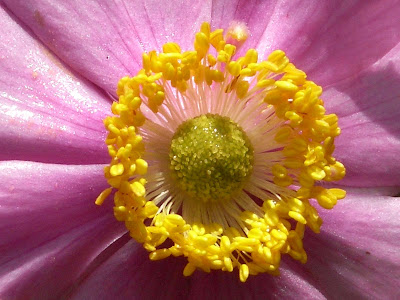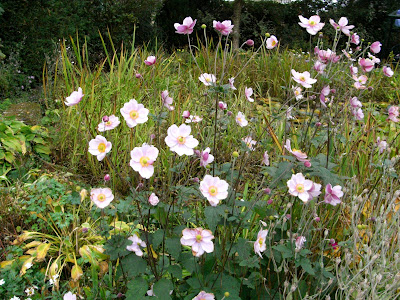 Large White And Red Admiral Butterflies On Michaelmas Daisies
Large White And Red Admiral Butterflies On Michaelmas Daisies
At the
beginning of October
the sun shone brightly and our visiting butterflies had their last sustenance from our Michaelmas daisies. After such a poor Summer, weather-wise, with a period of almost ten weeks of rain, we are having a glorious Autumn.
 Red Admiral and Hoverfly On Michaelmas Daisies
Red Admiral and Hoverfly On Michaelmas Daisies
It was a joy to observe the flurry of frenzied activity on the various posies of Michaelmas Daisies around our ponds. I, too, enjoyed the warmth of the sun on my back while taking my little video of the butterflies and hoverflies. It makes my heart sing to see the fruition of all the hard work in creating our garden, when intensive farming methods deprive little creatures of their habitats.
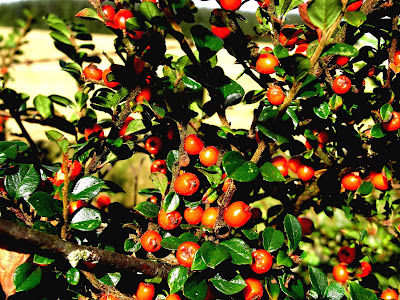 Red Cotoneaster Berries
Red Cotoneaster Berries
The birds and insects, too, have had a wonderful time gorging themselves on the Autumnal fruits and berries we provide for them. They had a choice of cotoneaster berries, rowan berries, crab apples, Japanese quince apples, the tomato-like hips on the
Rosa Rugosa hedge, hips on our climbing roses and a cornucopia of seedheads from all the herbaceous borders.
 White Bark Of The Jacquemontii Silver Birch Tree
White Bark Of The Jacquemontii Silver Birch Tree
Autumn is a wonderful sensory experience in the garden, with a rainbow of colour which paints a smile on the dullest of days. In this photograph, we can see the green leaves of the
Cornus Alba, the White Dogwood behind the silver birch, turning to gold. But, now that we are at the end of October, they are all but spent.
 View Across Part Of The Back Garden At Barleycorn
View Across Part Of The Back Garden At Barleycorn
Our garden is too large to leave all the cutting-back to the Spring, when we would be in danger of trampling our bulbs. It means, therefore, that, in Autumn, my hubbie and I spend a fair amount of time cutting back spent stems which no longer bear seeds. It helps to encourage a new crown around the centre of the plants, which, in turn, protects them over the Winter. As you can see from this photograph, we have left the foliage on the pond plants at this late date in the calendar, as they give shelter to a host of insects.
 Red Autumn Foliage On Joseph's Rock Rowan
Red Autumn Foliage On Joseph's Rock Rowan
When you come to view the little video (at the end of this post, made up of snippets taken during this month at Barleycorn) the Joseph's Rock Rowan has green foliage with yellow/orange berries. This photograph, however, shows the amazing transformation from green to yellow to its glorious red Autumnal coat...but, even as I type, the tree is almost in silhouette...
 Lily Leaves In The Pond
Lily Leaves In The Pond
I have said, many times, the ponds are a constant source of delight to us, and never more so than when they are wearing their Autumnal hues. As an amateur watercolourist, I delight in the photographs which show the play of light on the ponds. The reflections never cease to amaze me.
 The Potentilla Hedge Up The Drive
The Potentilla Hedge Up The Drive
Our
Potentilla hedge, planted by my hubbie, flowers for six months of the year and feeds insects and birds to their heart's content. Whenever we walk its length, sparrows are chattering amongst its thick-set foliage, safe in the knowledge we can scarcely spy them. On frosty days, it is often draped in dew-filled spiders' webs, which, like so many fairy necklaces, exude an air of magic.
 Hosta Foliage In Autumn
Hosta Foliage In Autumn
Even though many gardeners are keen to tidy up, I prefer to leave the hosta leaves until they disappear by themselves into the ground. On dry days, I like nothing better than coming across a filigree-patterned leaf, with only the skeleton of the veins showing.
 Crocosmia Leaves And Spent Grasses
Crocosmia Leaves And Spent Grasses
Once or twice, we have come across a hedgehog's nest in the garden. They are shaped like a rugby ball with the lower half underground in a hollow in the earth and the top half made from the long foliage of grasses and crocosmia, all woven together with hedgehog spittle. Once, to our delight, we found three babies inside. However, on closer inspection, we found they were dead, and we wondered if their mother had been killed on the road, as is, sadly, often the case.
 Lichens On Logs
Lichens On Logs
Here and there, around the garden, we have logs for insects to hide in and to chew. Over the years we have had to replace many of them as the insects, and the weather, have reduced them to smithereens. The glaucous blue lichens growing on these logs are worth a closer inspection. Just click on the photograph.
 Taz, The Barn Cat, Under A Weeping Birch Tree
Taz, The Barn Cat, Under A Weeping Birch Tree
Those of you, who follow the blog, will know that Taz had a friend called Cookie who shared the barn with him for the past four years. Her original owners have now decided to take her back to live with them and their seven new cats. No sooner has that happened than a new cat, jet black with green eyes, has made himself at home in the barn. Since the barn is 70 foot long, they will be able to give each other a wide berth if they fail to bond.
 White Iceberg Climbing Rose
White Iceberg Climbing Rose
This climbing rose stays with us till January. I am so glad it is so hardy, and is covered in heads at the moment. Hoverflies, flies, spiders, and a myriad of other insects feed on it, and, in turn, they feed the birds. Although its foliage sometimes suffers from a spot of mildew, the blooms don't seem to be affected.
 Crimson Glory Climbing Rose
Crimson Glory Climbing Rose
This rose has been growing up the wall next to our back door for eighteen years now. It has a profusion of blooms throughout the Summer and has a pleasing fragrance. I miss its cheery colour when it goes to sleep next month.
 Ox-Eye Daisies
Ox-Eye Daisies
These daisies spread themselves freely around the garden and I love them for it. They brighten dark areas of the garden, such as next to this pile of twigs and logs. Each head always seems cheerful to me with the golden cups of sunshine in their centres. They open with the dawn and close at dusk, which is why they are called the day's eye...
 Who Goes There?
Who Goes There?
I am a light sleeper and often hear our local
Barn Owl screeching as it catches its prey during the night. Often there is a large pile of feathers lying along one of our paths. This pile looks to have been left by a sparrowhawk though, as I often see one de-feathering a smaller bird in the same spot... near the stane-dyke wall adjacent to the field behind our garden, so that he has access to a quick getaway.
 Balloon Over Barleycorn
Balloon Over Barleycorn
Our October weather has been perfect for ballooning and the prevailing winds often carry the balloon over our house. I always greet the travellers with a friendly wave and they often call down to me. Three years ago, our elder son and his new bride treated us to a flight and it was a wonderful experience flying over our village, cameras at the ready, taking aerial views of our garden.
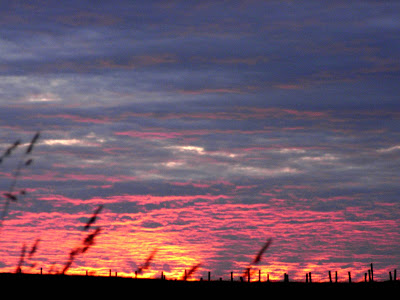 Sunset Behind Barleycorn
Sunset Behind Barleycorn
We do not always have beautiful Autumn sunsets, so I made the best of an opportunity to take several photographs of the ones we have enjoyed this month. In this photograph, as the sun neared the horizon it became a fiery red.
 Sunset Behind Barleycorn 2
Sunset Behind Barleycorn 2
It's always exciting to have the silhouettes of trees in the foreground. The tree in the middle is a Holly so it will stay in that form. But, the two either side of it are Silver Birches, and, gradually, they will become more streamlined.




























